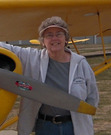Sarah Byrn Rickman's Blog, page 6
December 4, 2020
December 7, 1941: “The Day That Will Live in Infamy”
“At 7:55 a.m. on Sunday, Dec. 7, 1941, a Japanese force of 183 airplanes attacked U.S. military and naval facilities on Oahu in the Hawaiian Islands without warning. For 30 minutes, dive bombers, level bombers and torpedo planes struck airfields and naval vessels.
“After a 15-minute lull, a second wave of 170 planes launched another attack at 8:40 a.m. that lasted an hour. Casualties to U.S. service personnel were 2,343 killed, 960 missing and 1,272 wounded; Japanese aircraft destroyed 151 U.S. planes on the ground and sank or damaged all eight U.S. battleships at anchor in Pearl Harbor. At a cost of only 28 airplanes shot down, the Japanese had dealt the United States a staggering blow.”
Courtesy the National Museum of the US Air Force
*****
President Roosevelt called December 7, 1941 “The Day that Will Live in Infamy.”
A Japanese leader was heard to say: “I think we have awakened the Sleeping Giant.”
YEP!
Flight to Destiny — the Novel
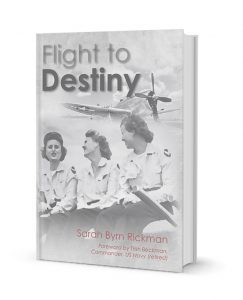
I’ve written a novel about that attack and its aftermath. It features, briefly, a real-life woman pilot named Cornelia Fort who was flying near Pearl Harbor that day and survived the attack. She went on to fly with the WASP — the American women pilots who volunteered to fly during World War II, as civilians. My fictional protagonist, Annie Gwynn, goes on to do the same. The WASP did NOT fly combat or anywhere abroad. Rather, they ferried (flew and delivered) airplanes throughout the United States, taking them wherever they needed to go. Winning the war was the goal.
The e-book version is on special sale, December 7th and 8th — in memory of Pearl Harbor. https://www.amazon.com/dp/B086VSBS19/
Here’s a Teaser from Chapter One
Early morning, December 7, 1941
Annie Gwynn nudged the control stick to the left, touched her foot to the left rudder pedal, and put the small, single-engine airplane into a shallow bank.
The early morning mist had vanished from the green valleys between the rugged mountains that overlooked Pearl Harbor. Having lost track of Cornelia’s plane, she began to search for it. Instead of her friend’s yellow trainer, in the distance Annie saw moving specks— specks that caught the rays of the rising sun.
A flock of birds? Too big. Airplanes? She squinted through the windscreen. The specks — yes, airplanes — and coming toward her, closing on her.
Now she could see dozens, maybe hundreds of planes. They resembled a swarm of angry bees. Seconds later, the lead aircraft banked right and turned south and she caught sight of a red ball on the wing. The other airplanes followed the leader. All but one. It peeled off and flew toward her.
On a Collision Course
The two planes were on a collision course with Annie’s much smaller, slower aircraft the vulnerable one. Alarm bells were going off in Annie’s brain. Red ball. The Rising Sun? Japanese? Impossible. But that sleek silver airplane closed on her fast.
Annie shoved the throttle to the firewall. Her stomach did a rollercoaster flutter as she put the airplane in a sudden dive, mindful that she didn’t have a lot of altitude to lose in these hills. But Annie knew she had to do something to evade the silver menace that came straight at her.
She heard what sounded like machine gun fire and bullets whining overhead. Keep the nose down, she thought. Annie swung first left and then right, hoping to spoil his aim. She knew any minute a burst of those bullets would rip through the fabric of the little Cub and tear her to shreds.
Annie eased back on the stick and banked right, beginning a gradual climb to regain her lost altitude, then turned in her seat to look back.
Pearl Harbor Was on Fire
Columns of smoke rose from Pearl Harbor. They fouled the bright blue morning sky with a dirty pall that threatened to obliterate the few fleecy clouds that floated high over paradise.
Annie dropped down just above the treetops as she made her way between two hills. Now she saw flames towering higher than a five-story building and leaping from listing ships in the middle of the harbor. Smoke billowed wherever she looked. Plumes of water from fire hoses shot skyward then fell as millions of droplets, only to be turned to steam when they contacted the molten metal of the burning ships that lay dying amidst what had been the United States’ Pacific fleet.
The water itself appeared to be on fire. Japanese planes zoomed back and forth, diving, climbing, turning, shooting at everything that moved — planes, boats, trucks, cars, bicycles, people.
The gravel northeast to southwest runway in her sights, she dropped even lower and swung in an arc keeping the airplane below the horizon — the rounded line drawn by the crests of the hills — hoping a Jap Zero would not see her. A bright yellow aircraft was easy to spot on a sunlit morning. Annie said a silent prayer as she throttled back and prepared to land.
Thank you for reading my blog. Please see all my books on Amazon.com:https://www.amazon.com/s?k=Sarah+Byrn&i=stripbooks&ref=nb_sb_noss_2
The post December 7, 1941: “The Day That Will Live in Infamy” appeared first on Sarah Byrn Rickman.
November 6, 2020
A Poem Dedicated to Betty Gillies
Fog shrouds the wings; dawn, but a shard of light.
Twin engines labor, eager to unbridle the horses.
Toes, hard on brakes, check the trembling aircraft.
From the tower, “Cleared for takeoff.”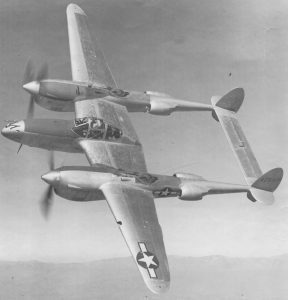
Brakes off. Throttle to the firewall.
Spine thrust back against the seat.
Rolling, rumbling, reaching,
Wheels eat up runway. Lift.
Ease yoke back. Climb!
Eyes on instruments. Don’t look out!
The Pacific, invisible, lies below.
Altimeter reads seven…eight…nine hundred feet…
A shock of blue—a cloudless sky.
Execute a 180, bearing due east.
Sunrays strike silver wings, turning them gold.
Oh to pull over, stop in mid air, drink it all in!
Below, murky black stuff;
Ahead, two snow-covered peaks,
Sunlight rising through the pass between them.
Above it all, a sleek P-38 flies on wings of gold.
© 2016 Sarah Byrn Rickman
This poem is inspired by, and dedicated to, Betty Huyler Gillies, second in command, Women’s Auxiliary Ferrying Squadron, 1942-1944. In an oral history recorded in 1996, Betty used some of these words to describe her first flight in a P-38 twin-engine pursuit aircraft that she ferried from Long Beach, California to Newark, New Jersey.
Betty is the subject of my newest book:
Betty Gillies WAFS Pilot
The Days and Flights of a World War II Squadron Leader
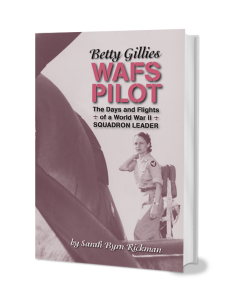
The post A Poem Dedicated to Betty Gillies appeared first on Sarah Byrn Rickman.
October 24, 2020
Watch the “Betty Gillies WAFS Pilot” Launch Party
Betty Gillies WAFS Pilot officially launched on Oct 15, 2020. Watch the launch party, featuring some wonderful stories about Betty by members of her family.
From Sarah: I can’t believe it has been a week since we did this! To all my friends out there, PLEASE WATCH!!!
And THANK YOU for reading my blog!!!
The post Watch the “Betty Gillies WAFS Pilot” Launch Party appeared first on Sarah Byrn Rickman.
October 2, 2020
Betty Gillies WAFS Pilot Debuts in Two Weeks!
Mary, my marketing manager (mary@buythebookmarketing.com) and I invite you to join us for Betty’s Book Launch Party — on ZOOM — Thursday, October 15th at 11 a.m. Mountain Time; 10 a.m. Pacific Time; 1 p.m. Eastern Time; and Noon Central Time. More about this in next week’s blog/newsletter.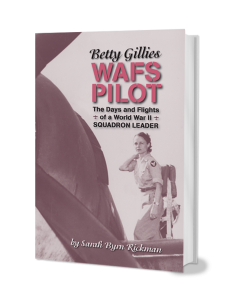
I plan to read a couple of excerpts from the book.
Much of this book is based on Betty’s WAFS/WASP World War II diaries, dated September 6, 1942 to December 21, 1944. Already a committed diary chronicler, Betty didn’t let her hectic wartime schedule and demands on her time and attention keep her from jotting down a few lines about the day she had just been through.
Her narratives of her more frustrating ferry flights may astonish you! You will learn that she was a night owl. But, you’ll also note that she was avowed early riser.
https://www.amazon.com/s?k=betty+gillies+wafs+pilot&i
Betty Flew the Mighty P-47 Thunderbolt
Betty was 5 feet 1½ inches tall. She flew the biggest pursuit (fighter) airplane the U.S. had in the war, the 14,500-pound, single-engine, single-seat P-47 Thunderbolt. Truth be told, she flew more than 100 of them, most of those in 1944. She was one helluva pilot.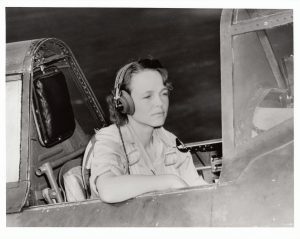
Betty’s granddaughter, Glen, is joining us for the party. Those of you who knew Betty, and who know Glen, please come say “hi” to her. My grandkids and daughter-in-law here in Colorado Springs will join us as well.
My friend and fellow Ninety-Nines member, Jacque Boyd, will be with us. Jacque and I have known each other for close to 30 years. She urged me to join Women in Aviation and I urged her to join Women Writing the West, a worthy step for each of us. And she encouraged me to learn to fly when I told her of my lifelong dream to do so.
Here in Colorado Springs I belong to a writers group — we call ourselves We Band of Writers — and some of them will join us as well. We meet twice a month on Zoom to read our latest efforts aloud, then talk about them. That works really well because all but one of us no longer works outside the home. After all, we ARE writers! But Covid has made us more home bound than we used to be.
Betty’s Book Is a Reality In Spite of Covid
Covid made it necessary for me to publish my own book — for the first time. Welcome to “Flight to Destiny Press.” And of course, were it not for Covid, we’d be having a LIVE LAUNCH PARTY somewhere nice, serving refreshments, and I might even get to sign and sell some books!!!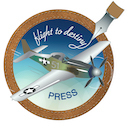
Betty Gillies WAFS Pilot will be available for order on Amazon.com next week as a softcover edition, selling for $12.95. It is available for order now as an e-book, priced at $6.99. If someone wants an autographed copy, those will need to be ordered from me. We’ll post a link in next week’s blog on how to make that happen.
Since my subject played such an active role in World War II, I had my heart set on publishing this year. My target release date was August 14, to mark the 75th anniversary of VJ-Day, the day Japan surrendered. I wanted to do that because I’ll never forget that day.
I’ll Never Forget August 14, 1945 — VJ Day
I was 8-years old. My entire formal education had taken place in wartime. I started Kindergarten in January 1942. Every week at school, I took my dime to buy a special 10 cent stamp to fill my stamp book to buy a War Bond. From First Grade on, I took a quarter and bought a 25-cent stamp. War Bonds financed the war. They were sold at 75 percent of their face value. A $25 bond cost $18.75.
It matured over ten years. I remember when my father and I cashed some of them in to buy stock. I was 16.
I watched my mother juggle her ration books before going to the grocery store. We had paper drives at school. I sang “Praise the Lord and Pass the Ammunition!” And I sang “Nothing Can Stop the Army Air Corps.” — I still have to think to say “Air Force,” much to my retired Air Force officer son’s chagrin.
On Friday August 14, 1945, we heard the news that the Japanese had surrendered and the war was over.
We Marched on 6th Avenue, the #6 Streetcar Line
It was a Friday, my mother was playing golf, and I was visiting at a friend’s house. She lived along the Sixth Avenue #6 streetcar line in East Denver. We grabbed pots, pans and spoons from her mother’s kitchen and went outside to march along the streetcar tracks. Other kids joined us.
We made a makeshift sign to carry using part of the front-page headline in the Rocky Mountain News. In huge type, it read: The War’s Over. As the streetcars, loaded with commuters going home from work, rattled by, we marched up and down Sixth Avenue and shouted to the riders. They cheered back. What an afternoon!
That’s why I wanted to launch Betty’s story THAT DAY, because she was such an integral part of that war and of helping assure victory. A couple of technical publishing realities kept me from making my deadline. Sobeit!!!
Join Me October 15th for Betty’s Book Launch
On October 15, 2020, I’m releasing to the reading public a book about a dedicated, determined woman who was, I repeat, one helluva pilot and a true patriot. That’s my World War II story. I hope, now, you’ll read hers: Betty Gillies WAFS Pilot: The Days and Flights of a World War II Squadron Leader. https://www.amazon.com/s?k=betty+gillies+wafs+pilot&i
Thank you for reading my blog!
The post Betty Gillies WAFS Pilot Debuts in Two Weeks! appeared first on Sarah Byrn Rickman.
September 10, 2020
Betty Gillies – First to Join Nancy Love’s WAFS
On October 15, my tenth published book, Betty Gillies WAFS Pilot: The Days and Flights of a World War II Squadron Leader, makes its debut. It will be available on Amazon as both a paper back and an e-book. As you might guess, I am thrilled to make this announcement. This book is aimed at young women ages 12 and up, but makes really good adult reading as well. Betty was a “doer.”
My first book, The ORIGINALS, debuted 19 years ago this week. What a journey this has been! And it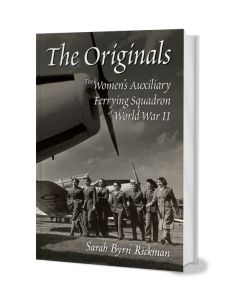 took me a long time to get here.
took me a long time to get here.
I Found My Calling at Age 5
I’ve wanted to write books from the time I was 5 years old. I made up my own Pooh Bear story, dictated it to my aunt, who was visiting at the time, and then illustrated the book with crayon drawings of Pooh, Piglet, Eeyore, Kanga and Roo. Did I mention I was sick in bed with the measles at the time and very bored?
From the day The ORIGINALS was published, I wanted to write Betty Gillies’ story. I also wanted to write about Nancy Love, Nancy Batson Crews, BJ Erickson, and Dorothy Scott. I have since written those four, but others are still on my radar screen. Why? Because their stories reached out and grabbed my attention, unlike many other stories I have heard over a lifetime.
In 1942, when the WAFS and subsequently the WASP began, women had been flying almost as long as men. Men, since 1903; women, since 1910. [And Katharine Wright flew WITH her brother Wilbur in 1908 in France.]
Meet the First Women to Fly in America
American women Bessica Raiche and Blanche Stuart Scott both “flew” in 1910. In fact the dates of their first flights are at best two weeks apart. On September 16, 1910, Bessica flew her husband Frank’s homebuilt aircraft, and she did so with no prior instruction or experience. Between September 2 and 12, 1910, Blanche Stuart Scott put an aircraft into flight, but it may have been by accident.
Blanche was the only woman to whom aviation pioneer Glenn Curtiss ever gave flight instruction. Curtiss didn’t think women belonged in aircraft. [How ’bout that ladies!!!]
Curtiss blocked the throttle of her biplane to keep it from gathering sufficient speed to take off. However, Blanche was taxiing the aircraft when something, possibly a gust of wind, lifted the aircraft from the ground and it flew to an altitude of forty feet and then settled gently back to earth. [Take that, Glen!!]
Sources place the date between September 2 and 12, 1910, but, according to those sources, most likely it took place on September 2.
Did Blanche Intentionally Remove the Block?
In one account, Scott takes credit for intentionally removing the block from the throttle, unbeknownst to Curtiss, and taking off. [Hee hee!] Not the first woman to take the initiative to get what she wanted. Gutsy Blanche never did get her pilot’s license but continued to do stunt flying until 1916, when she quit by choice. One of her favorite stunts was flying upside down under bridges. You go girl!!!
The Aeronautical Society of America credits Raiche as the first woman to pilot and solo an aircraft in America. The Early Birds of America gives that honor to Blanche Scott. The Early Birds of Aviation is an organization devoted to the history of early pilots. It was started in 1928 and accepted a membership of 598 pioneering aviators.
Bessica Raiche herself said: “Blanche deserved the recognition, but I got more attention because of my lifestyle. I drove an automobile, was active in sports like shooting and swimming, and I even wore riding pants and knickers. People who did not know me or understand me looked down on this behavior. I was an accomplished musician, painter and linguist. I enjoyed life, and just wanted to be myself.” [Again, you go girl!]
The First Four Licensed American Women Pilots
The first four American women to obtain pilot’s licenses from the Aero Club of America and the prestigious Fédération Aéronautique Internationale (FAI) were Harriet Quimby, #37, on August 1, 1911; Mathilde Moisant, #44, on August 17, 1911; Julia Clark, #133, on May 19, 1912; and Katherine Stinson, #148, on July 24, 1912. Katherine’s younger sister, Marjorie, was not far behind. The sisters later trained English and Canadian pilots to fly in World War I.
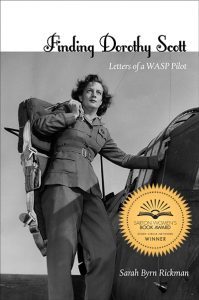 This information on early American women pilots above is taken from the Introduction in my 7th book, Finding Dorothy Scott: Letters of a WASP Pilot. More to come in future blogs.
This information on early American women pilots above is taken from the Introduction in my 7th book, Finding Dorothy Scott: Letters of a WASP Pilot. More to come in future blogs.
Find all my books at: https://www.amazon.com/Sarah-Byrn-Rickman/e/B001JS2MSA?

Enjoy!!!
Watch for Betty October 15th!
And thank you for reading my blog!
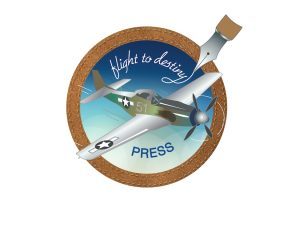
The post Betty Gillies – First to Join Nancy Love’s WAFS appeared first on Sarah Byrn Rickman.
September 3, 2020
WWII – WASP Ferry Planes Headed for Russia in 1944
This week’s blog is going to be short, but sweet. In it I’m offering links to TWO PODCASTS that I did last month.
The originator of these podcasts is the Bravo 369 Flight Foundation and the guys in charge have become friends of mine: Craig Lang and I met in 2014 when I was at the Museum of Flight in Seattle to do a WASP presentation; and Jeff Geer, Chairman of BRAVO 369 — who I have yet to meet in person — but we’ve talked a lot. Jeff and I have established a mutual admiration society via phone and the two podcasts.
Bravo 369 Mission Statement:
The BRAVO 369 Flight Foundation is a 501(c) (3) non-profit organization dedicated to education and the preservation of historical aircraft and aviation history through books and documentary film . Our main objective is to offer unique educational opportunities for students, teachers, and the general public to actively participate in a series of interactive and educational flight re-creation projects. https://bravo369.org and https://www.warplanestosiberia.com
The project that I joined them on this summer is “Warplanes to Siberia.”
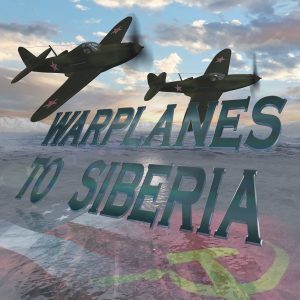
BRAVO 369
Q: Why am I, the author of books about the WASP — the women who flew in World War II —participating in a “Warplanes to Siberia” project?
A: WASP who flew for the Ferry Command in WWII ferried P-39 and P-63 warplanes [pursuits also known as fighter aircraft] to Great Falls, Montana, in 1944. There, U.S. male ferry pilots flew them on to Fairbanks, Alaska. There, Russian pilots picked them up and flew them to Siberia — or wherever else the Russians wanted them to go.
Q. Why didn’t the WASP take the planes on to Alaska?
A. The base in Fairbanks could not accommodate them with bed and board. Besides, ferrying across western Canada was risky. If a ferry pilot went down in those dense forests, rescue could be a problem. The Ferrying Division, Air Transport Command, did not want to put the women pilots in that kind of danger.
Part of WWII’s Lend Lease Program
Through my podcasts with Jeff and Craig, you will learn lots more about this wartime Lend Lease program and the the role the U.S. women pilots of WWII played in it.
Episode 6: Parts 1 and 2, please listen:
August 26th podcast — Here’s the link: https://www.buzzsprout.com/1181306/5018117
September 2nd podcast — Here’s the link: https://www.buzzsprout.com/1181306/5018696
This from Jeff: The podcast is listed with several major podcast directories such as Apple Podcasts, Apple iTunes, Spotify, Google Podcasts etc. The full list of Warplanes to Siberia podcast episodes may be found at https://warplanestosiberia.buzzsprout.com/
Enjoy!!!
*****
From Sarah: Thanks for reading my books. Here’s where to find them online:
https://www.amazon.com/Sarah-Byrn-Rickman/e/B001JS2MSA?

Coming October 15 from Flight to Destiny Press, Sarah’s latest:

The post WWII – WASP Ferry Planes Headed for Russia in 1944 appeared first on Sarah Byrn Rickman.
August 28, 2020
Endowed Flight Scholarship in WASP’s Name
*** Names Women’s Flight Scholarship for Beesy ***
The Beverly L. Beesemyer Endowed Scholarship for Women in Aviation is now a reality at Maricopa Community College, Phoenix AZ.
Fritz and Derek Beesemyer have established this scholarship to honor their Aunt Bev and her fellow WASP (Women Airforce Service Pilots) of World War II, to give those women coming up behind them financial assistance to pursue their dreams. The annual scholarship will be awarded to qualified students who demonstrate a commitment to the completion of a flight training degree program required for a career in commercial aviation.
Here is the link to the page for donations to the scholarship: https://mcccdf.org/beesemyeraviation/
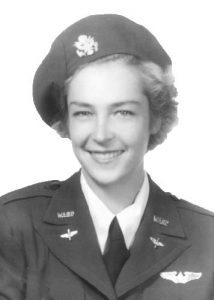
Bev Beesemyer, WASP Class 44-6: Photo courtesy Texas Woman’s University, WASP Archives
‘Beesy’
By Sarah Byrn Rickman, WASP Author and Historian
June 22, I received a delightful phone call. The gentleman calling identified himself as Fritz Beesemyer.
“You’re one of Beesy’s nephews!”
To say that both he and I were delighted with the connection is an understatement.
I am the editor of the WASP News, published by the WASP Archive at Texas Woman’s University, Denton. Fritz wanted to tell the surviving WASP and their followers about this new scholarship in their sister WASP’s name. Could I please tell them that future women pilots at Maricopa Community College will learn to fly because of Bev Beesemyer, WASP Class 44-8.
Beverly Beesemyer was a rare and marvelous human being. May I say, what a gal! She was one of only 1,102 women to serve as WASP pilots during World War II. If you haven’t heard of the WASP before, you are in for a treat.
World War II’s Best Kept Secret
These gals still are WWII’s best kept secret, but all of Bev’s WASP Friends, and all the WASP Kids (fondly known as KOWS or Kids of WASP) and other relatives, are here to tell you that their WWII service was extraordinary. Women ages 18½ to 35 with varying degrees of flight experience volunteered to serve this country when she most needed them.
When “The War” began, the U.S. didn’t have enough pilots — male pilots — to fight this conflict thrust on us. So the women came to the rescue, volunteered to “learn to fly the Army way,” and serve their country flying anything the men and their big brass would let them fly.
The gals wanted to advance — transition up — and they DID. They started in small trainers, but many managed to move up into some “big stuff.” And because the women wanted to fly, a lot of them opted to fly “dishwashing” jobs the guys didn’t want — like flying aircraft assigned to tow gunnery targets.
You Get Shot At, So To Speak
If the teenagers down on the beach in North Carolina didn’t aim quite right at the canvas target you were towing, your A-24 dive bomber likely would get some bullets in its tail. At least they weren’t hitting the cockpit — were they?
Beverly Beesemyer flew one of the big ones, the B-26 twin-engine bomber — also known as the “widow maker.” Tricky, tough to fly, that airplane. Its wings didn’t seem quite long enough to keep the airplane in the air. So they called her “the flying prostitute” … “no visible means of support.” Beesy loved that big ol’ airplane. In later years she painted pictures of it and put herself in the cockpit. And she was a darn good artist!
Bev celebrated her 100th birthday August 25, 2018. Sadly, we lost her October 29, that year.
Awarded Congressional Gold Medal, March 10, 2010
Beverly and her fellow WASP performed unprecedented service during World War II. Their determination to serve their country and the contributions they made went largely unnoticed until 300 survivors of the WASP community received the Congressional Gold Medal on March 10, 2010, for their service.
Beesy wearing a WASP Fifinella T-shirt.
From an article in the WASP News, Summer 2018: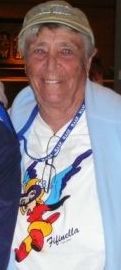
Bev’s last airplane ride, December 2017, was a joy.
“Beverly Beesemyer is a spitfire!” Christina Pascucci, a KTLA-TV Los Angeles reporter, said of Beesy after flying with her. “She’s so feisty, lucid and strong. She sets a new bar for what women should aspire to be. She’s a trailblazer.”
“It’s Your Airplane!”
That day, Christina took Beesy up for a spin in a Cessna 172 — just the two of them. Christina had a small camera mounted above the instrument panel so she could film Beesy in flight. “Your airplane,” Christina said — the standard verbal method of communication used between a pilot and her copilot (or a student) when transferring the controls during flight. “The look on her face — the joy when she took control of the yoke from me — it was a joy for me to see.
“She kept looking up at the clouds — in awe. She was back in her happy place, oohing and aahing.” —
RIP Beesy, from all of us! Blue skies and tail winds!
*****
Thanks for reading my blog. Hope you enjoyed reading about Beesy. To find copies of my books about the WASP, please visit:
https://www.amazon.com/s?k=sarah+byrn+rickman&i=stripbooks&crid=1
The post appeared first on Sarah Byrn Rickman.
August 21, 2020
Guest Blog: In Covid Times, Check Out Home Schooling
Consider Experiential and Classical Christian Education
by Amy Rickman, Educator
Time is precious! Life with our kids at home will only last so many years. Make each moment count! Our family has focused on home schooling as a lifestyle for 8 years. Experiential learning — learning through real life experiences — along with Classical Christian Education is where this journey has taken us.
Giving our kids meaningful knowledge and life skills is our focus. The key is to allow them to explore their interests along with learning fundamental educational concepts. Our family spends a lot of time outdoors enjoying the beautiful Colorado environment. We love to travel, do projects, go on many field trips, visit museums, and spend time with special friends and family. Reading and listening to lots of books is another favorite past time for us, as is playing games.
Style/Philosophy
If I had to classify my style it would be classical and experiential with a focus on books. My philosophy is:
Read, read, read
Make learning a joy
Experience life, concepts, responsibilities, and places first-hand through trips and real life as much as possible
Turn anything, any location, and anyone into a learning opportunity
Increase our faith with various resources while we spend time savoring God’s beautiful world
My goal is for my children to be equipped to understand God’s world. Although we utilize the computer for supplemental support, screens are not our focus.
Emaline and Daniel at Bryce Canyon
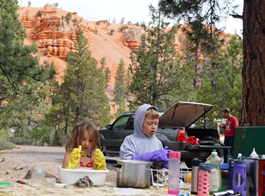 If I have the choice between teaching something from a book and going to experience it, I choose the experience to support whatever we are studying. While watching a documentary on Bryce Canyon is interesting, seeing the overwhelming beauty of Bryce Canyon in person can be inspirational. Learning about volcanoes is intriguing, but peering into an active volcano, as we did in Nicaragua, is thrilling!
If I have the choice between teaching something from a book and going to experience it, I choose the experience to support whatever we are studying. While watching a documentary on Bryce Canyon is interesting, seeing the overwhelming beauty of Bryce Canyon in person can be inspirational. Learning about volcanoes is intriguing, but peering into an active volcano, as we did in Nicaragua, is thrilling!
Meeting ‘History’ Face to Face
Learning history can be fascinating. Talking to someone who lived during a particular time is far more engaging than just reading about it. My husband’s mom, Sarah Byrn Rickman, is the author of 10 books about the women pilots who flew in World War II: the Women Airforce Service Pilots — better known as WASP. Sarah now focuses on writing books about the WASP that are aimed at today’s young women ages 11-15. Her goal is to show that women who lived many years ago had dreams and the determination to do great and unusual things — like fly airplanes — just as young women today want to do great and exciting things. Girls can be whatever they want to be and are willing to work to be, is her message.
Through Sarah, our kids met and developed relationships with some of the WASP. That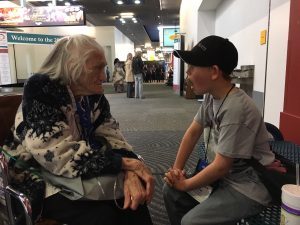 first-hand experience brought their history and the history of WWII into a whole new perspective. Our son established a special relationship with WASP Millie Young while attending Women in Aviation with Sarah in Reno in 2018. (see photo). Millie, who we lost in 2019, also lived in Colorado Springs.
first-hand experience brought their history and the history of WWII into a whole new perspective. Our son established a special relationship with WASP Millie Young while attending Women in Aviation with Sarah in Reno in 2018. (see photo). Millie, who we lost in 2019, also lived in Colorado Springs.
Millie and Daniel deep in discussion.
CC is a Christian program that lasts 24 weeks. Each CC group meets together one day a week for a community day. Families continue memory work at home for the rest of the week. CC communities are found all over the country and in many locations overseas, especially close to U.S. military installations. My children have attended CC and I have served as a CC tutor for five years.
Overview of the CC Foundations Curriculum:
The CC manual is designed for ages 4-12. All CCs follow the same three-year sequence — 1. Ancient Kingdoms, 2. Medieval, and 3. Modern times. Each class has no more than 8 children with one tutor and at least one parent. Kids usually look forward to community day because the class time is so engaging.
The morning is divided into 30-minute sessions: Grammar; Fine Arts; Presentations; Hands-on Science; and Review. Math, History, Language and Geography are incorporated into these sessions.
Students train their mind to retain information.
“CC” Essentials is the program for 9-12-year-olds. It is held in the afternoon following Foundations Curriculum. It consists of
Grammar: The focus is an in-depth knowledge of grammar.
Math: The kids play math games to sharpen their mental math skills.
Writing: The last 45 minutes is spent learning to write and present papers using the Institute for Excellence in Writing (IEW) program. The kids usually work on a paper at home during the week and read the paper in class.
Learning Styles: All learning styles —Visual, Auditory, and Kinesthetic — are incorporated into every area in Foundations. For more info on CC: https://www.classicalconversations.com/.
Additional Curriculum and Programs
CC does not provide a full math program. I have used Math-U-See with our kids. https://mathusee.com/. Using short videos, a math teacher explains the content of each lesson then the children do the problems on a worksheet. It works very well.
Science: https://www.apologia.com/ is a curriculum; https://www.homeschoolsciencecolorado.com/ is a hands on program through which home school children can compete in the science olympiad.
Spelling: https://www.allaboutlearningpress.com/all-about-spelling/
Reading/Spelling for Dyslexia: https://bartonreading.com/
Music: https://pikespeakhomeschoolband.org/musical-programs/. Organized bands and strings programs for homeschooled children.
Foreign Language: CC does teach basic Latin, but the full Latin program begins when kids begin Challenge at age 12.
Keyboarding/Typing: typing.com
Home School Co-ops: https://actshsc.wixsite.com/acts
Sports (Colorado): https://www.cshsl.org/
Experiential Learning Opportunities :
Zoo
Space Foundation
Science Museums
Special Camps
Acting
Science
Sports
Field, Day and Road Trips:
Local/State/National Parks
Field trips
Chico Basin Ranch is a working cattle and training ranch. This location also offers a program during bird migrations. An ornithologist catches and identifies birds. http://www.chicobasinranch.net/
Cripple Creek has a mine tour http://www.goldminetours.com/ and train https://cripplecreekrailroad.com/ that is worth the time.
Littleton Museum: https://littletongov.org/city-services/city-departments/museum
Denver Science has free days: https://www.dmns.org/
Colorado Wolf Center: https://www.wolfeducation.org/
Denver Aquarium has home school days with special programs: https://www.aquariumrestaurants.com/downtownaquariumdenver/default.asp
WWII Museum: This place has educational programs that home schoolers can attend. Their collection of aircraft is impressive. Volunteers restore aircraft at this location. https://www.worldwariiaviation.org/
The USAFA was showing freeing IMAX movies to the public. School programs are offered for free at their Planetarium with a local astronomer. The USAFA has a free museum and tour of the campus. https://www.usafa.edu/academics/facilities/planetarium/
The Old Town Museum in Burlington was worth the drive: https://www.oldtownburlington.com/
Rock Ledge Ranch is another favorite in the summer when living characters are in the different locations showing history from Native Americans to the 1800s. https://rockledgeranch.com/
Denver History Museum: https://www.historycolorado.org/history-colorado-center
Peterson AFB offers a program called Starbase that is geared towards fifth graders and is science focused. Home schoolers can join with other school programs. Starbase also offers summer day camps. https://dodstarbase.org/
Civil Air Patrol (CAP)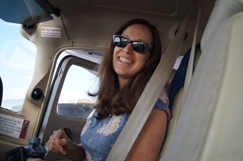
CAP provides aviation and science resources to educators. For around $35 per year, an educator is given a free flight on a small aircraft and access to free educational kits and resources. We received a full flight simulator from CAP that has been a highlight in our home. I also used the materials provided and the flight simulator to teach an aviation class for our co-op. https://www.gocivilairpatrol.com/
Amy was delighted to get a flight in a small plane.
Additional Resources:
Young Eagles — EAA (the Experimental Aircraft Association) — provides free introductory air flights for children 8 and up. https://www.eaa.org/eaa/youth/free-ye-flights/eaa-flight-plan/eaa-student-membership-step-2-of-eaa-flight-plan
Five in Row is the primary curriculum I used for the first few years when my children were younger. https://fiveinarow.com/
Lapbooking or Notebooking is project-based learning that is put into a folder. https://heartandsoulhomeschooling.com/list-of-free-lapbooks-for-every-subject/
Sally Clarkson is a local author with numerous, helpful resources, https://wholeheart.org/
Home School Legal Defense Association (HSDLA): This is a good option to assist in navigating legal issues that relate to home schooling. Our family is a member of HSLDA. https://hslda.org/
PLEASE FORWARD THIS TO YOUR FRIENDS WHO MIGHT BE INTERESTED.
From Sarah: Thank you for reading my daughter-in-law’s Guest Blog. I hope it is helpful to parents looking for alternative ways of schooling in these trying times.
The post Guest Blog: In Covid Times, Check Out Home Schooling appeared first on Sarah Byrn Rickman.
August 13, 2020
Betty Gillies WAFS Pilot — Coming October 15
The Days and Flights of a World War II Squadron Leader
By Sarah Byrn Rickman, from Flight to Destiny Press

Release date: October 15, 2020
The sun creased the horizon.
Suspended in the bubble-enclosed cockpit of the twin-engine, twin-tailed P-38 Lightning, the pilot pressed her toes hard against the brakes. The aircraft trembled, ready to fly.
Eyes focused on the instrument panel, she watched the dials and gauges that would tell her when the engines reached takeoff power.
“It was still dark and smoggy—a typical morning in Long Beach with dense, low-hanging clouds. I couldn’t see very well, but when the control tower said ‘ go, ’ I went. ”
She lifted her toes from the brakes and shoved the throttles to full power, “pouring the coals” to the engines. The surge held her against the seat as the Lightning’s wheels rolled faster, faster, faster, gaining momentum. The wind caught beneath the wings and lifted the silver aircraft from the runway. A swirling brown murk engulfed the plane. The ground vanished.
Now flying blind, she kept her eyes on the instruments in front of her. Her left hand on the throttles, her right hand held the controls that determined the aircraft’s upward movement. The silver plane climbed through the darkness.
“At nine hundred feet, the airplane burst through into a cloudless blue sky. The sun’s rays hit my silver wings and turned them to gold. I wanted to pull something and stop right there in the air.
“Below was fog and black stuff. Directly in front of me were these two snow-covered peaks, well over ten thousand feet, the sun coming up through the pass between them.
“ And above it all was this sleek airplane, flying on wings of gold. ”
The woman pilot flying that aircraft was Betty Huyler Gillies.
I Wanted to Write Betty’s Story
Betty: P-47 cockpit. — Photo courtesy International Women’s Air and Space Museum
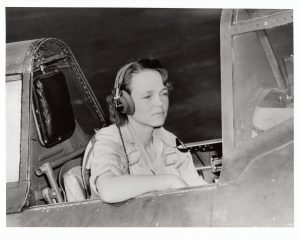 Since I first learned about Betty Gillies and her role as Nancy Love’s second-in-command during the WAFS/WASP days of World War II, I’ve wanted to write about her.
Since I first learned about Betty Gillies and her role as Nancy Love’s second-in-command during the WAFS/WASP days of World War II, I’ve wanted to write about her.
Early in 2018, I emailed Betty’s granddaughter, Glen, and told her of my interest in writing Betty’s WWII story. I explained that I was the author of several books about the original WAFS, written for an adult audience, but that my last two books had been aimed instead at girls grades six to eight. Could we talk?
She and her father, Betty’s son Pete Gillies, were willing to meet with me and discuss my telling Betty’s WWII story. I went to work on yet a third book written to appeal to today’s young women, but I broadened the range. My aim now is age 12 on up to adult readers. In writing for today’s young women I hope, also, to reach their sisters, mothers, aunts, cousins, and grandmothers.
Women Who ‘Look to the Stars’
Now, I write for all women who, like the WAFS and WASP of WWII before them, dare to “look to the stars.”
The women pilots of WWII offer inspiration for today’s young women. Girls who are searching, struggling in those middle school and early high school years, might like to read about these women of accomplishment … in unusual fields. Flying military aircraft, after all, is far afield of what is normally thought of as woman’s work!!!
The world has changed. We need to exercise the art of the possible.
Today, we encourage girls to explore STEM — education in Science, Technology, Engineering and Math. All those fields relate to aviation. An added enticement, those 1940s pilots were attractive, accomplished young women of their time. Yes, role models.
Betty was totally on board with Nancy Love’s determination to offer her women ferry pilots the same option enjoyed by male pilots. That was the opportunity to check out on any aircraft they could prove themselves capable of flying. No restrictions because of gender. And the men of the Ferrying Division came around to Nancy’s way of thinking.
Living Proof, Women Fly
Already, Betty was living proof that it could be done. She flew many types of aircraft before joining the WAFS. Once in a position to ferry army planes, she again flew anything she could get her hands on, from the smallest to the largest of aircraft.
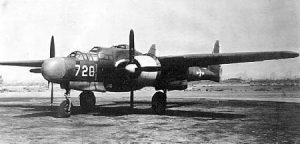
Northrop P-61A-1-NO 3/4 front view (S/N 42-5488) Fourth block 1 aircraft built. Photo taken Aug. 25, 1944. (U.S. Air Force photo)
She picked up her first P-61 Black Widow — the Army’s newest twin-engine night fighter — in Sacramento. With only one overnight stop enroute, she flew it across the continent to the docks at Newark, New Jersey. There, the P-61 immediately was loaded aboard a Liberty ship and sent to England and the war. That Black Widow sported two 2800-horsepower engines and had a fuel capacity of 646 gallons.
Then Betty caught the night train back to base.
The next morning, an order came to move a Piper Cub liaison plane from Richmond, Virginia, to Reading, Pennsylvania. Having just reported back to base, Betty was the only woman on base not already on assignment. The job was hers. She caught the train to Richmond and picked up the Cub.
Consider the Contrast in Those Missions
Betty had just flown the Army’s newest, best and brightest — the P-61. Now she flew the much used and abused, 60-horsepower, single-engine Cub with an 11-gallon fuel tank to Reading where it would be sold as war surplus.
Consider the contrast in those two back-to-back missions.
What, if any, was the urgency of the Cub flight? What difference, if any, did it make if the Cub was delivered today or tomorrow considering its fate? But in the Army, orders were orders.
Betty wrote in her diary that night: “Gee, I have fun. Sounds like a lot of trouble, but I enjoy it!”
That Notation Was Pure Betty!
Such was the life of a pilot flying for the Ferrying Division, Air Transport Command in WWII. And that just scratches the surface of what this woman pilot, the subject of my latest book, did.
 Please read Betty Gillies WAFS Pilot: The Days and Flights of a World War II Squadron Commander. From Flight to Destiny Press. Available October 15 on Amazon as well as on Kindle.
Please read Betty Gillies WAFS Pilot: The Days and Flights of a World War II Squadron Commander. From Flight to Destiny Press. Available October 15 on Amazon as well as on Kindle.
And, please, ask your daughters, granddaughters, nieces, and their friends to give it a read as well!
Click here to watch the book trailer.
*****
From Sarah: “Thanks for reading my Blog!”
VJ Day Was 75 Years Ago Today, August 14, 1945
That’s what Betty, the WAFS, the WASP, and ALL the men of the Armed Forces were fighting for! For those of us on the Home Front, sweet victory!
The post Betty Gillies WAFS Pilot — Coming October 15 appeared first on Sarah Byrn Rickman.
August 6, 2020
International Women’s Air & Space Museum (IWASM)
Centerville OH ’86-’98; Cleveland OH ’98 to Present
“When did you first become connected with IWASM?” Heather Alexander, IWASM administrator asked me a few days ago. IWASM stands for International Women’s Air and Space Museum. “It was 1986,” I told her. The museum had just opened in Centerville, Ohio, three blocks from my home.
I was, at that time, the editor of the Centerville-Bellbrook Times, a twice weekly newspaper covering south suburban Dayton, Ohio. Three women asked to speak to me about doing an article in the Times about the new museum. All three were pilots and they immediately got my attention. Little did they know they wanted to talk about a subject that long ago grabbed my interest.
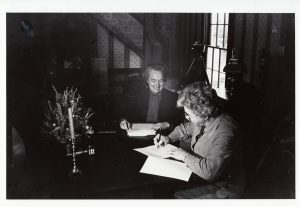
At 13, I read about Amelia Earhart and was, thereafter, thoroughly entranced by her story. These three women brought me stories of her and many more women pilots of the 1920s and ’30s and beyond. A museum dedicated to them and their fascinating ever-growing history had become part of my community. WOW!!!
(Left) Centerville Mayor Shirley Heintz and IWASM President Nancy Hopkins Tier sign 1986 Memorandum of Understanding at the Museum.
Joan Hrubec, the museum administrator, became my close friend and prime go-to person for answers to my history-of-aviation questions for the next 20 years. IWASM President Nancy Hopkins Tier, then in her 70s and still flying, was a charter member of the Ninety-Nines, the Organization of Women Pilots. She was there in the room with Amelia and others for that momentous first meeting November 2, 1929. Completing the triumvirate visiting me that day was museum 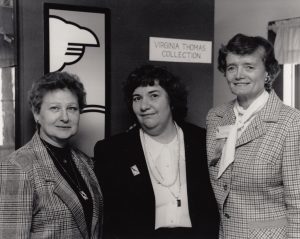 executive vice president B Steadman, best known as one of the Mercury 13. In 1960-61, she was one of 13 women pilots who successfully passed the same testing as did the original six U.S. astronauts.
executive vice president B Steadman, best known as one of the Mercury 13. In 1960-61, she was one of 13 women pilots who successfully passed the same testing as did the original six U.S. astronauts.
Right: Joan Hrubec, Carol Gallaten, B Steadman—1988.
I Was in the Company of Women’s Aviation Royalty!
My relationship with IWASM began that day and still continues today. Of course the Centerville-Bellbrook Times ran the museum’s story.
My association grew over the next three years. I met more women pilots including another charter 99, Fay Gillis Wells. I wrote recently of meeting my first WASP (Women Airforce Service Pilots) Nadine Nagle and my first WAFS (Women’s Auxiliary Ferrying Squadron) Nancy Batson Crews — both through IWASM.
Below: Nancy Tier celebrates IWASM’s one year anniversary in Centerville.
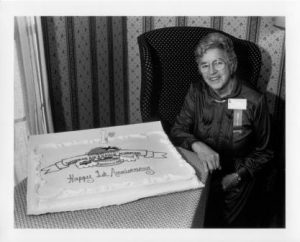 I left the newspaper in 1989 to explore a writing career on my own. In 1990 I went to work for the museum as a ten dollar an hour / ten-hour-a-month contractor. Fortunately, for my fledgling freelance writing business, I had two better paying clients. But this one I loved. It was pure fun, done for the sheer enjoyment. Later, I became a volunteer advisor, a position I hold to this day.
I left the newspaper in 1989 to explore a writing career on my own. In 1990 I went to work for the museum as a ten dollar an hour / ten-hour-a-month contractor. Fortunately, for my fledgling freelance writing business, I had two better paying clients. But this one I loved. It was pure fun, done for the sheer enjoyment. Later, I became a volunteer advisor, a position I hold to this day.
A Move to Cleveland in 1998
IWASM left Centerville in 1998 to move to Burke Lakefront Airport on the southern tip of Lake Erie in Cleveland. They needed more space. Another pressing reason was Joan and the new President, Connie Luhta, both lived in Cleveland. The long-term commute, including the apartment they had to keep in Centerville, was expensive.
At Burke, the exhibits are spread out along the concourse — actual displays, including an airplane. Glass cases contain trophies, artifacts, written accounts of what they are and who donated them. One currently holds a replica of the gown worn by the diminutive Katharine Wright when she and her famous brothers, Orville and Wilbur, met President Taft, June 10, 1909. The original, a gift from the Wright family when the museum was in suburban Dayton, has been displayed in the past.
First Women’s Air Race: 1929
The women who flew in “the teens” during World War I are featured. Then came the Roarin’ ’20s with Amelia, Phoebe Fairgrave Omlie, and Louise Thaden, winner the first women’s air race, the Powder Puff Derby in August 1929. That famous race led to the creation of the Ninety-Nines. The 20 women who flew the Powder Puff Derby began the discussions of a woman pilot organization during their evening stops along the route of the race.
(Suggestion: read Gene Nora Jessen’s The Powder Puff Derby of 1929.)
The 1930s brought us Helen Richey, Bobbi Trout, Fay Gillis Wells, Ruth Nichols, Nancy Love, Jackie Cochran, Betty Huyler Gillies and many more. The 1940s brought us the WAFS and the WASP.
The big story in women’s aviation from 1947 through 1977 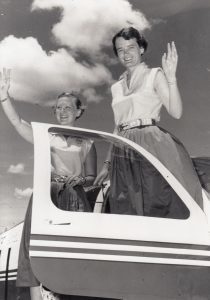 was AWTAR (the All-Woman’s Transcontinental Air Race). The best of America’s women pilots and many from other countries competed in that annual race. And with Sally Ride’s journey into space in 1983, the growing corps of women astronauts became a huge part of the IWASM story — thus the “Space” designation in the title. Retired astronaut Cady Coleman, then an Air Force officer, was directly involved with IWASM in the early ’90s prior to joining NASA.
was AWTAR (the All-Woman’s Transcontinental Air Race). The best of America’s women pilots and many from other countries competed in that annual race. And with Sally Ride’s journey into space in 1983, the growing corps of women astronauts became a huge part of the IWASM story — thus the “Space” designation in the title. Retired astronaut Cady Coleman, then an Air Force officer, was directly involved with IWASM in the early ’90s prior to joining NASA.
Right: Joan and B fly the AWTAR in 1955
Joan and I introduced our videotaped “Women in Aviation” lecture series in Centerville in November 1990 featuring Nancy Tier. B Steadman spoke to us in January 1991, and a panel of International Women Airline Pilots representing their organization, ISA+21, gave our March 1991 presentation. Mercury 13 (November 1991) and WASP (January 1992) panels followed.
Enter Women Military Pilots
Desert Storm introduced IWASM to the “new” female military. Army Medivac helicopter pilot Ann Patrie and nurse/paramedic Lori Combs joined us for the evening in November 1992. Their Desert Storm exhibit is displayed in the concourse. Also part of that panel was Air Force C-141 transport pilot Captain Kathy Gotch (Staiger). These women flew in Desert Storm (Jan/Feb. 1991) marking women pilots’ entry into active participation in military flight, BUT their role still was non-combat. That was about to change in 1993, with Defense Advisory Committee on Women in the Services (DACOWITS).
Emily Howell Warner, the first woman jet-age airline pilot (1973), spoke to us. Aerobatics champion Patti Wagstaff came to speak and our own museum board member, WASP Caro Bayley Bosca, joined her for the presentation. Caro was the women’s aerobatic champion back in the early 1950s.
Three of Us Remain from the Centerville Days
My direct involvement ceased when the museum moved to Cleveland, but today, I’m still an adviser, life-member, and loyal supporter. Joan, Nancy Tier, B, Nadine, and Caro all are gone now. Connie Luhta, Board secretary Susan Schulhoff Lau, and I are the remnants of the Centerville days. Heather and a whole new crew run the operation in Cleveland.
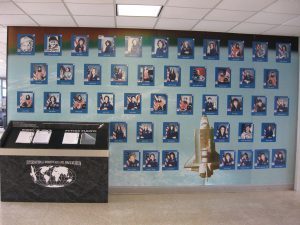
Right: Wall of Women Astronauts, Cleveland
The museum’s collection includes artifacts, photographs, articles, textiles, artwork and paper items relating to the history of women in aviation and space. Finding aids for some of the collections are available online. If you are conducting research on women in air and space, the Fay Gillis Wells Research Center is an excellent resource. Check with the museum for information.
Please visit the museum at Burke Lakefront Airport, Room 165, 1501 N. Marginal Road, Cleveland, Ohio, 44114: Phone: 216-623-1111; Website: www.iwasm.org. Do yourself a favor, get on the email list for the monthly newsletter. They have a great aviation-focused gift shop!
*******
Footnotes
At a ceremony at the White House, Washington, D.C., June 10, 1909, President William Howard Taft presented Aero Club of America gold medals to the Wright Brothers, Wilbur and Orville. Katharine, too, was invited. https://airandspace.si.edu/collection-objects/taft-william-howard-president-wright-katharine-wright-orville-wright-wilbur
The U.S. Defense Department Advisory Committee on Women in the Services (DACOWITS) was established in 1951 by Secretary of Defense George C. Marshall. Its members are civilian women and men appointed by the Secretary of Defense to provide advice and recommendations on matters and policies relating to the recruitment and retention, treatment, employment, integration, and well-being of women in the U.S. Armed Forces. https://en.wikipedia.org/wiki/Defense_Department_Advisory_Committee_on_Women_in_the_Services
From Sarah: Thank you for reading my blog! Please check out my books about women pilots on Amazon:
https://www.amazon.com/s?k=Sarah+Byrn+Rickman&i=stripbooks&ref=nb_sb_noss_2
The post International Women’s Air & Space Museum (IWASM) appeared first on Sarah Byrn Rickman.

